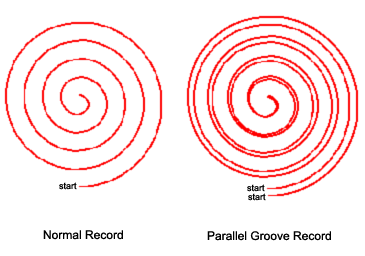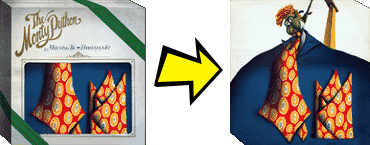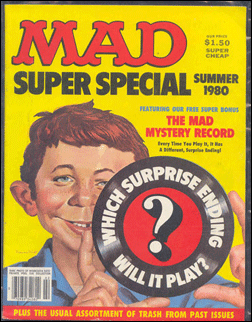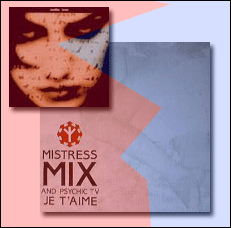Some of the more interesting variations that can occur during vinyl manufacturing occur while the master plates are being cut. While a normal record’s grooves consist of one continuous spiral, the only strict limitations on how the grooves can be cut lie in the standards imposed by the turntable. One innovation that I’ve discovered in researching unique records is the practice of cutting two or more parallel grooves into the same side of a record. In the case of a two-grooved record, when the needle is dropped you may hear one of two entirely different ‘sides.’

This practice cuts the time available per side down by a facter of n (n being the number of parallel grooves). For example, suppose a one grooved record can hold 20 minutes of music. A two-grooved record can in turn hold 10 minutes of music in each groove, which adds up to 20 minutes for the side. Sticklers who want to know exactly how much an LP can hold per side might be interested to learn that it’s variable:
“Generally speaking, each side of an LP should not exceed around 20 to 25
minutes to maintain an ideal signal to noise ratio. To manufacture longer play times, more grooves must be put on the vinyl, and the overall volume has to be lowered and the dynamics compressed. This allows the groove to be physically smaller, but also lowers the signal to noise ratio.”
I’ve done a bit of research on this variety of record and have thus far been unable to track down a definitive ‘first’ record to employ the technique. Collectors of 78 RPM records in the newgroups maintain that this was done ‘a lot’ in the 30’s and 40’s. In the limited reading I’ve done on the topic, the most cited example (by far) is Monty Python’s ‘Matching Tie and Handkerchief‘ album.
I went to Ann Arbor’s vinyl repository, Encore Records to see if I could pick up a copy so I could experience the double groove in question. Sure enough, there amongst the comedy section in the back, I found a copy (Albeit sans ‘Tie and Handkerchief’). I brought the record home and experienced the parallel groove in all its glory. I showed it to friends, sometimes taking up to seven tries to hit the alternate groove. Patience was tried, glory was had.

In every newsgroup post on the topic, someone mentions this record:
“I had this album for months before I heard the third side. I never could figure out why the second side seemed so much shorter than the first. Also, the original cover actually came with a tie stuffed into the cover so you could see it on the outside. Unfortunately, due to costs it was cut early on. even worse, at about the same time, they put it into a regular jacket and used only two sides. i have an original though, i NEVER found this out until i bought the Monty Python autobiography, very funny!!!”
I’ve been unable to confirm the ‘Real tie’ part of the story. Also unconfirmed thus far:
“This phenomenom appeared on a free Monty Python flexi 7″, which was given away on the cover of NME (if memory serves). On one groove was The lumber jack song, and I think the other was the election results sketch. Forgive me if the facts aren’t entirely accurate but it was a hell of a long time ago.”
It appears comedy records were the ‘early adopters’ of this technology, as I’ve also found mention of a Henny Youngman record of one-liners that has four seperate grooves (Though I’m not sure which Henny Youngman record…), and a National Lampoon LP, “That’s Not Funny, That’s Sick!” which had parallel grooves on both sides. I’ve also found a few postings mentioning a Cheech and Chong album that used the groove for more then just hidden storage – it was part of the joke:
“Cheech & Chong did something similar with the “Rip-Off Album”. Each side had two grooves. One groove contained the album, and the other was a groove that went the entire length and simply said “You’ve been ripped off” over and over. This made it entirely possible that no matter where you put the needle, on either side, you could get the second [“You’ve been ripped off”] groove.”
“If memory serves me right, this was accompanied by a huge advertising and marketing campaign for the album, which consisted mostly of C&C saying not to buy the album, it’s a rip off, etc.”
…which sounds great in theory, but everyone who mentions this links back to the article quoted above, and I haven’t been able to independently verify its existence.
Perhaps the ultimate in parallel groove technology was Mad Magazine’s ‘It’s a Super Spectacular Day,’ a flexi-disc included in the 1980 Super Special which featured eight possible parallel-groove endings:
“Halfway through the disc, after the cheerful intro, the extra grooves took over and the record played a gloomy/funny description of possible disastrous events that totally ruin your day. There were 8 scenarios total and whichever one played depended on which groove the stylus happened to make contact with – totally random! I had to play the thing 25-30 times before I could hear all 8 of ’em! You can hear all eight endings on the Totally MAD CD 4, ‘Somewhere in the Middle Years’.”

You can view the lyrics to all the alternate conclusions here, if you’re so inclined.
‘Real’ Music
The parallel groove technique has also made several appearances in the world of ‘serious’ music, with some using it more creatively than others. I’ve compiled a list of all that I was able to find mention of on the web:
- LL Cool J – Goin’ Back To Cali / Radio / Jack The Ripper ‘Three sided’ 10″ single.
- Soft Verdict – 7″ on Belgium’s Collectible Crepuscule label (early 1980s): three parallel groove tracks on the b-side.
- Kate Bush – “Sensual World” 12″ single. One track contains the standard vocal version and the other an instrumental version.
- Fine Young Cannibals – “Good Thing” 12″ single (1989). Two different mixes of the same song in parallel grooves.
- M – “Pop Muzik” European 12″ single. Double grooved with two mixes. “It was highly irritating
back then in the late 1970’s but now I actually enjoy the randomness…” - Sonic Youth – “100%” and “Youth against Fascism”, both 10″ singles from 1992-ish on Geffen. Each side has 2 songs, one in each groove. “Maddingly frustrating if you want to hear a specific song.”
- I am Spoonbender – Teletwin 12″.
- Various Artists – The “Music Maniac Gimmick Compilation” (Germany, late 1980’s). A two record set with two or three grooves on every side. “A tribute to the phonograph record and the weirdest LP ever. Cut ‘trick-track’ with 3 parallel grooves on each side, clear vinyl, no labels, spoken introductions, free boardgame and a cover with optical illusions.”
- “The book “Rare Rock” by Tony Rees mentions a Rush promo from the Seventies that featured six different grooves with six different songs. The name of the record: ‘Rush’n Roulette.'”
- “You’re the Guy I Want to Share my Money With”, on Giorno Poetry Systems Records. Laurie Anderson, William Burroughs, and John Giorno each take Sides 1 to 3, and on Side 4 there are three tracks (one by each artist) that run as parallel grooves.
Good & Evil / Happy & Sad
I found two interesting records that use the inherent duality of the parallel grooves in the themes of the recordings contained within them. One is a single by Psychic TV (It looks to be ‘Je T’aime,’ though I’m not positive). Dropping the needle on this parallel groove, one can hear either the Pope or Anton Le Vey reciting their respective credos.

The other is ‘Brave,’ a 1994 album by prog-rockers Marillion:
“I don’t know how common it is, but Marillion’s last album ‘Brave’ was released as a double vinyl LP with the final side existing as two grooves – one with a ‘happy’ ending and one with an ‘unhappy’ ending (its a concept album…)”
Further Details on ‘Brave’ Straight from the band:
“The 2LP vinyl release of Brave features a double groove on the second side of disc 2. The first groove plays ‘The Great Escape’ as heard on the CD, followed by ‘Made Again’; the second groove plays ‘The Great Escape (Spiral Remake)’ and 20 minutes of water noise. This provides 2 different endings to the album story, depending on where you drop the needle.”
A bit of research reveals that a full-length movie version of Brave, directed by Richard Stanley, was released in Europe in conjunction with the album. The VHS is currently out of print, but EMI are planning to release a DVD version in the summer of 2004. The only review on the imdb entry for the movie reveals the plot:
“Brave was Marillion’s seventh studio album, their third with Steve Hogarth. It was that most unfashionable of products, a concept album from a prog-rock outfit in the early 90’s.”
“The story was complete invention, starting from a real event; the police found a young woman wandering on a motorway bridge. She couldn’t or wouldn’t tell them anything. From this starting point, the group wove a story which covered abuse by her father as a child, moving on into drug abuse and a few other events leading to her being on the bridge, contemplating suicide.”
“The film is an interpretation of the story, with the co-operation of the band – although they feature only in passing on screen. This film is about as far from MTV video as it’s possible to get!”
“The story is mostly told via the images and Marillion’s music – there is little dialogue. As such, I feel the film is something of a curate’s egg; some of it works really well, while others need more explanation. The scenes with the Hollow Man (the man in the mask) could do with something extra, since it’s not really clear if this is simply a barrier the girl erects to protect her from people who hurt her, a cipher that means these people are interchangeable, or something else entirely.”
“Not a bad effort, but not brilliant, either. If you’re unfamiliar with the original album, be prepared to be baffled the first couple of times through.”
Fun & Games
The novelty of the parallel groove technique seems ideal for use on children’s records, but I found information on only a few. What I did find was vague at best. One poster in the rec.music.collecting.vinyl newsgroup remembers a ‘changing story’ 78, with multiple ‘switching points’ where new parallel grooves would begin:
“When I was a child in the early ’50s I had a Bugs Bunny 78 that had two grooves per side, with two track regions per side, with a break between them. When the tone arm was put down the needle would fall into one of the two tracks; then at the break in the middle it would again select one of the two tracks of the second region. So the choices at each of the four sections on both sides were 2-2-2-2, for a total of 16 possible
variations in the story being told. It was great fun to keep changing the story. But the record quickly wore a prefered path between the first and second track regions in the middle, which reduced the randomness to 2-1-2-1, or only four variations. So we learned to pick up the tone arm at the middle transition and restore it to regain the lost randomness. Alas, the record has been gone since the mid-’50s. This was a phonograph version of stories that had multiple choices within them as they jumped around different pages. My own children loved those when they were young; they were a favorite from the library.”
A few other children’s records of this sort that I’ve seen mentioned:
“I have a few 50s kiddie 45s where they did this sort of thing. The two off the top of my head that I have are “Engineer Bill’s Magic Record” on Mark 56 and “The Chariot Race Game” on RCA from the late 50s.”
“I’m not positive, but I even think that Decca put out at least one of these on their yellow/pink 88000 kiddie series in the early 50s.”
Another application of parallel grooves was in games. I’ve found a few vague mentions of horse racing games using multiple grooved records:
“At a garage sale years ago, I saw a bizarre “Horseless Horse Racing” family game. It consisted of fake racing forms and, of course, another of those multi-grooved records. Each groove featured a different victorious horse & bets were placed on them all. The rest is obvious…”
If you can fill in any of the blanks above, or are aware of any other records that have parallel grooves, let me know either via email or in the comments to this post. I plan on editing this post as I receive / discover new parallel groove records.
Also, ‘Parallel Groove’ is a good name for a funk band. So is ‘Concentric Groove.’